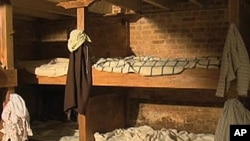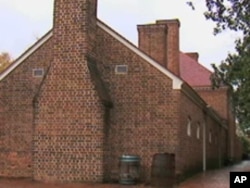George Washington was born into a world where slavery was an accepted part of life. When his father died in 1743, Washington - at the age of 11 - inherited 10 slaves.
When the nation's first president died in 1799, more than 300 slaves lived in quarters on his Mount Vernon estate. This year, those slave quarters, first opened to the public in 1962, went through an extensive archaeological analysis and restoration.
These refurbished quarters shed new light on the story of the slaves who lived and worked at Mount Vernon.
Hard life
The renovated quarters are two one-story wings added to the Mount Vernon greenhouse shortly after Washington became president. Each one is divided into two small workrooms, and two sleeping areas, one for men and another for women. Most of Washington's married slaves did not live in the same household as their spouses. Each room had a fireplace and was accessed by a single doorway.
"We have a lot of archaeological materials that we excavated from the slave quarter site," Archeologist Dennis Pogue says. "And from that, we know the kinds of things that they were actually using; the ceramics that they were eating from, the food remains. We found a lot of animal bones, so we know that they were eating lots and lots of wild animals-- that they were augmenting the rations that they were getting from the Washington's."
Pogue says documents written by George Washington, his family and white employees, and other plantation owners provided information about the quarters and the slaves who lived there.
"I mean we have some descriptions of what these quarters look like and they describe them as huts and they say 'They are more miserable than anything that you can imagine,'" Pogue says. "We don't want to whitewash this part of the story. These folks were owned by other people. They had no rights of their own and they were doing hard work."
Bringing history to life
The actual restoration of the site took almost 10 months. In addition to restoring the living quarters, clothing, tools, furniture, cookware, toys and personal accessories used by the slaves were reproduced. These items help bring to life the living conditions and experiences of the maids, cooks, servants, skilled craftsmen and laborers who worked on the five farms that made up the Mount Vernon property.
"It's a culmination of over 20 years of research. So it's wonderful to see this brought to the public's attention," he adds.
A number of descendants of George Washington's slaves attended the opening celebration of the restored quarters. Among them was Rohulamin Quander, a senior administrative judge in Washington, D.C. and founder of the Quander Historical Society.
"Sukey Bay was an 18th century Quander ancestor who lived at the River Farm," Quander says. "She had several children: Nancy Carter Quander and Rose, both were Sukey Bay's daughters. Nancy was a spinner. She lived up to 1850s. We have records for her working around in landscaping right here at Mount Vernon and other Quander family ancestors worked here. We have a long history of involuntary and presumably uncompensated servitude."
Last summer, the Quanders celebrated their 85th family reunion at Mount Vernon. Quander says renovating the slave quarters is a significant gesture of recognition for the hundreds of enslaved African Americans - men and women - who lived there.
"For many years, their names were forgotten,Quander adds. "The roles that they had played were forgotten. If the man they worked for, George Washington, is glorified, we want to give these men and women their just due because they were the ones who toiled from sunup to sundown, six to seven days a week, who made it possible for him to go off to do many, many great things that benefited all of us."
Learning opportunity
The chance to see what life was like for slaves by visiting the renovated slave quarters is a great opportunity for teachers like Beth Cayer. She's brought her 5th grade students on a field trip to Mount Vernon as part of their history class.
"It's beautiful. I hadn't seen it last year, so I was really excited for the kids to see it this year, because we've done a big unit about colonial America and we did a 4-day-lesson on slavery," Crayer says. "So it was a real eye-opener to a lot of the kids, the conditions that they lived in here. Of course some of the kids have the ancestors that came over that way. So it was a real eye-opener for them to see the contrast in life styles. It made a real impression on them."
Giving visitors a better understanding of the nature and harshness of slavery was one of the reasons for restoring the buildings. The point was not lost on Gloria Alice Holmes, another of Sukey Bay's descendants who came to Mount Vernon for the dedication ceremony.
"It's raining today," Holmes says. "I'd like to say in my opinion, the rain- that's the tears of the slaves saying thank you, thank you for not forgetting us."
Mount Vernon officials expect more than one million visitors to tour the restored slave quarters next year.









